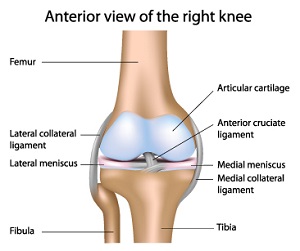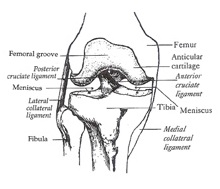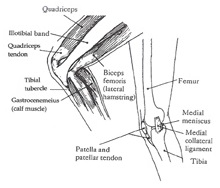
The children′s rhyme gets us started in the right direction. The knee is connected to the thighbone, but it may not be quite as simple as you think. Flexing or extending your knee moves three other bones besides the kneecap; the femur, or leg above the knee, connects to the tibia (shin) and the fibula (nonweight-bearing bone) of the leg below the knee. Protecting this joint is the kneecap, what you can think of as nature′s substitute for the pin in the hinge. When you extend, or straighten, your leg, you can feel the kneecap (patella) move down the front of the joint. It rides in the femoral groove, a depression, or trough, in the lower end of the thighbone. Below the kneecap is the top of the shin, which has a bump on front called the tibial tuberosity where the tendon holding the kneecap in place connects.
Keeping these bones connected are not other bones but four ligaments, two within the knee joint (cruciate ligaments) and two outside (collateral ligaments). The cruciate ligaments cross at the center of the knee and connect the thighbone and the shin. Cruciate means "cruciform" or "cross." The stronger of these two ligaments, the posterior cruciate ligament, connects from the posterior (back) to the front, and the anterior cruciate ligament connects from the front to the back. These ligaments work to prevent the shin′s moving forward or backward under the thighbone, hyperextending the knee, or hyperflexing the knee. The two collateral ligaments–the medial collateral ligament along the inside of the joint where the knees touch and the lateral collateral ligament on the outside of the leg–give the knee stability and work to prevent displacement sideward.
The major bones and ligaments of the knee.
Glide and Grind

Cartilage is what makes the movement of the bones a glide rather than a grind. In the knee, articular cartilage is a high-tech protective coating (like Teflon) for the surfaces of the bones facing the joint–the ends of the thighbone and shinbone and the back of the kneecap. Opalescent and somewhat transparent, this smooth, flexible, and in part elastic covering permits easy movement of the joint. Synovial fluid lubricates the system.
But absorbing most of the shock between the thighbone and the shinbone is another type of cartilage. Separate from the bones and different in structure from the articular cartilage, the meniscal cartilage buffers the shocks, bears the weight, and protects the bones. Like a washer in a plumbing assembly that has been halved into opposing crescents, two menisci (me-NEH-sky) in each knee surround the joint. They relieve friction and their outer third bears about 70 percent of the weight and shock the knee sustains. The menisci prevent the thighbone and shinbone from wearing on each other and thereby help protect the articular cartilage. The significance of this bit of anatomical engineering is evident in the price paid when a meniscus may be abused and lost because of a knee injury: early onset of disabling arthritis.
The tendons of the knee and the kneecap.

Tendons are transmitters. Made of white connective tissue, tendons are cords or bands that unite a muscle with a bone and transmit its force, causing movement. The most well-known tendon is the Achilles tendon, which connects the bone in the heel with the muscles in the calf. In the knee, tendons attach to the muscles of the thighs (quadriceps) and the kneecap. The kneecap resists the force of the tendon holding it in place. If the pressure between them remains balanced and no alignment problem exists, the kneecap moves predictably within the femoral groove. If the pressure becomes imbalanced by a sudden event, say, a slip that ends not in a fall but in a jolting recovery of balance, or a long-term training inequity that creates dramatically different strength levels in muscles attached to the tendons, the kneecap can crack or become dislocated.
This is a section from Dr. Jack E, Jensen’s book The One Stop Knee Shop. Read the next section Locating the Pain.


